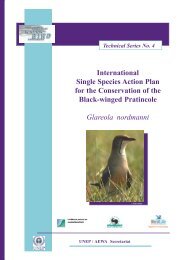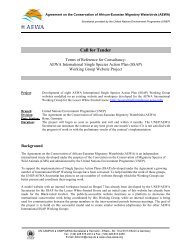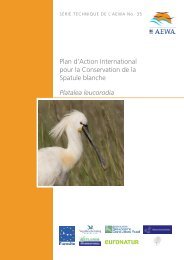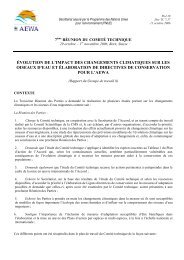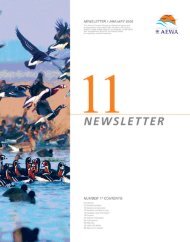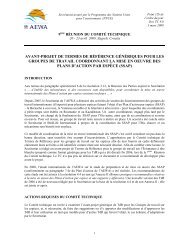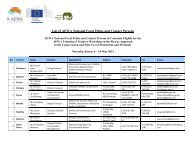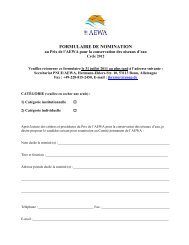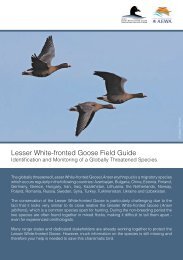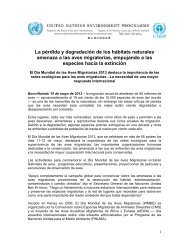International Single Species Action Plan for the ... - AEWA
International Single Species Action Plan for the ... - AEWA
International Single Species Action Plan for the ... - AEWA
You also want an ePaper? Increase the reach of your titles
YUMPU automatically turns print PDFs into web optimized ePapers that Google loves.
<strong>AEWA</strong> Technical Series No. 36 - Annexes<br />
ratios and o<strong>the</strong>r difficulties in finding mates, vulnerability to disease epidemics or o<strong>the</strong>r local<br />
catastrophes, and o<strong>the</strong>r problems intrinsic to small populations. The size of population below<br />
which extinction becomes likely varies among species, based on life history, habitat<br />
characteristics, evolutionary history, and o<strong>the</strong>r factors. It is perhaps misleading to consider<br />
any given number to be a “critical” population size, as smaller populations are at greater risk,<br />
but <strong>the</strong>re is no size below which a certainty of persistence changes to a certainty of extinction.<br />
However, <strong>for</strong> any given species and environment, <strong>the</strong> relationship between population size<br />
and extinction probability is amenable to analysis.<br />
For relatively long-lived vertebrates (such as geese and most birds), I do not believe that <strong>the</strong><br />
numbers that currently exist in <strong>the</strong> wild population of LWfG in Fennoscandia would allow<br />
classification of <strong>the</strong> population as ei<strong>the</strong>r “doomed” or “safe”. (I.e., both sides of <strong>the</strong> debate<br />
seem to have overstated <strong>the</strong>ir case.) Many populations have recovered from even lower<br />
numbers, such as <strong>the</strong> whooping crane recovering steadily from a low of only N=15, after<br />
protective measures were implemented. However, <strong>the</strong> whooping cranes did suffer a<br />
significant loss of genetic diversity, and this is likely a cause of <strong>the</strong> observed high rate of<br />
genetic anomalies of development and high susceptibility to some diseases. If <strong>the</strong> current<br />
population of about 20-30 breeding pairs of LWfG is so low as to make damaging genetic<br />
impoverishment inevitable, <strong>the</strong>n almost all captive populations of wildlife species would have<br />
to be considered to have no conservation value, as rarely are <strong>the</strong> captive stocks founded with<br />
more than 25-30 breeders. Fortunately, not very much genetic diversity is lost when a<br />
population goes through a bottleneck of about 20 pairs <strong>for</strong> one or a few generations. For<br />
example, 25 randomly breeding pairs would lose about 1% of its gene diversity<br />
(heterozygosity) per generation, allowing it to persist <strong>for</strong> 10 generations be<strong>for</strong>e it lost <strong>the</strong> 10%<br />
of gene diversity that has often been considered to be level of concern <strong>for</strong> stocks of wildlife or<br />
domesticated species. (Often, however, some pairs are much more productive than o<strong>the</strong>rs,<br />
ra<strong>the</strong>r than <strong>the</strong>re being a random distribution of breeding success, so actual losses of genetic<br />
diversity might be about twice this rate.)<br />
On <strong>the</strong> o<strong>the</strong>r hand, we should not have confidence that <strong>the</strong> population of LWfG in<br />
Fennoscandia can recover without assistance. First, <strong>the</strong> current steady decline must be<br />
stopped, or else all o<strong>the</strong>r conservation actions will provide at best only temporary assistance.<br />
After stopping <strong>the</strong> decline due apparently to hunting mortality, <strong>the</strong> existing population may or<br />
may not be able to recover without supplementation. The persistence to today of apparently a<br />
single remnant male ivory-billed woodpecker and o<strong>the</strong>r examples of presumed species losses<br />
that have been avoided (or delayed) should not be taken to be evidence that that species or<br />
any species can recover from very low numbers. Florida pan<strong>the</strong>rs declined to perhaps only<br />
10-20 breeding individuals <strong>for</strong> several generations, and <strong>the</strong> severe inbreeding effects were<br />
reversed only after intercrossing with ano<strong>the</strong>r population. Black-footed ferrets had been<br />
presumed to have been rescued after a decline to only about 10 unrelated animals (and <strong>the</strong>ir<br />
offspring), but <strong>the</strong>y are now showing declining reproductive success that most likely results<br />
from <strong>the</strong> inbreeding that occurred in <strong>the</strong> population bottleneck. The wild population of LWfG<br />
is approaching <strong>the</strong> level at which we might soon see dangerous effects of inbreeding, but <strong>the</strong><br />
population should still be recoverable, especially if occasional natural or manipulated<br />
immigration from central and eastern populations occurs.<br />
If a captive stock is used <strong>for</strong> supplementation of <strong>the</strong> wild LWfG, it would be wise (in light of<br />
<strong>the</strong> data discussed above) to initiate that stock with birds that are “pure” LWfG. Starting new<br />
stocks from birds captured in Fennoscandia or more eastern populations might be costly, but<br />
perhaps no more so than <strong>the</strong> extensive genetic testing that would be needed to derive a pure or<br />
largely pure population from existing captive stocks. In addition, existing captive stocks have<br />
not been managed to minimize genetic changes, so <strong>the</strong>y may have adapted genetically to<br />
captivity in ways that include loss of species-typical breeding preferences that serve as<br />
isolating mechanisms. After a population is established, monitoring and genetic management<br />
of a captive population is not much more difficult or costly than maintaining a population<br />
<strong>International</strong> <strong>Single</strong> <strong>Species</strong> <strong>Action</strong> <strong>Plan</strong> Lesser White-fronted Goose –Annexes<br />
LI



